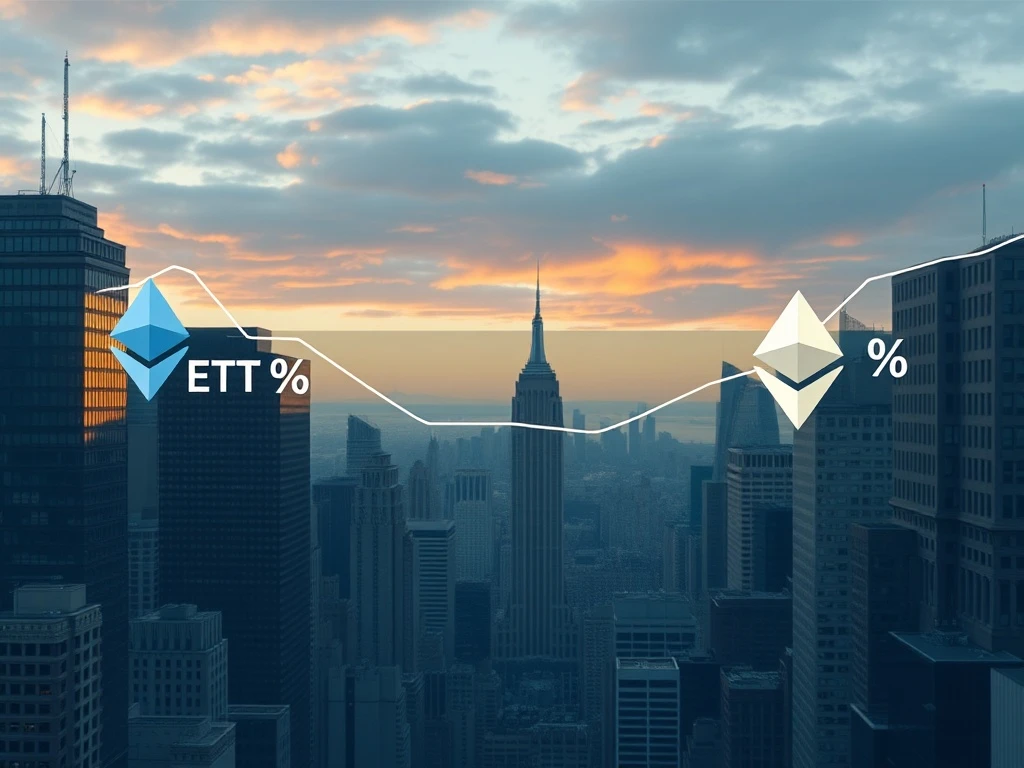Ethereum Supply Plummets: Wall Street’s Massive Accumulation Drives ETH Off Exchanges

The cryptocurrency market often provides fascinating shifts. Recently, a significant trend has emerged concerning Ether supply on centralized exchanges. This movement indicates a substantial change in investor behavior. It highlights a growing institutional interest in Ethereum (ETH). Such shifts can influence market dynamics considerably.
Ether Supply Dips to Nine-Year Low
The amount of Ether (ETH) held on centralized crypto exchanges has fallen dramatically. It now sits at its lowest level since 2016. Data from Glassnode shows Ethereum exchange balances dropped to 14.8 million ETH. This marks a significant 9-year low. Furthermore, CryptoQuant reports a similar trend. Their Ethereum exchange supply ratio, which compares exchange reserves to total supply, reached 0.14. This figure is also the lowest since July 2016. These metrics clearly indicate a major exodus of ETH from trading platforms. This trend began in mid-2020 and has intensified recently. In fact, over the last two years, the ETH supply on exchanges has been cut in half. The accelerated decline started in mid-July, seeing a 20% reduction since then. Investors are moving their assets, signalling a potential long-term holding strategy.
When exchange supplies decrease, it usually suggests that assets are being transferred. They move into cold storage, staking protocols, or decentralized finance (DeFi) for higher yields. Conversely, an increase in exchange balances often signals that investors are preparing to sell. The current trend therefore points towards reduced immediate selling pressure. It suggests a bullish sentiment among holders. This strategic movement of assets can strengthen the overall market position of Ethereum. It also reflects growing confidence in its future value. The continuous decline in exchange reserves highlights a shift in market sentiment.
Accelerated Net Outflows and Reduced Selling Pressure
Net outflows of Ethereum are accelerating significantly. CryptoQuant data confirms this trend. The 30-day moving average of total Ethereum exchange net flows reached its highest level since late 2022 this week. This indicates a rapid acceleration in these outflows. CryptoQuant author CryptoOnchain noted, “Large-scale withdrawals often indicate a shift toward self-custody or DeFi deployments, reducing exchange liquidity and immediate selling pressure.” This observation is crucial for understanding market dynamics. It suggests a reduced availability of ETH for immediate trading. This scarcity could potentially impact price stability.
Moreover, Glassnode’s exchange net position change recorded a negative 2.18 million ETH on a recent Wednesday. This figure is remarkably high. It has been surpassed only five times over the past decade. Such a substantial negative change underscores the scale of recent withdrawals. It also reinforces the idea of reduced selling pressure. Investors are actively choosing to hold their ETH off exchanges. This decision aligns with a long-term investment perspective. It removes a significant portion of the supply from easily accessible trading pools. This strategic move could have lasting implications for Ethereum’s market valuation.
Institutional ETH Accumulation Surges
A primary driver behind these accelerated outflows is the aggressive institutional ETH accumulation. Corporate Ether treasuries are actively acquiring large amounts of the asset. For example, Tom Lee-chaired BitMine now holds over 2% of the total supply. This firm began aggressively accumulating ETH in June. Since April, approximately 68 entities have collectively scooped up 5.26 million ETH. This represents around $21.7 billion and 4.3% of the entire supply. StrategicEthReserve provided these figures. Most of these entities are staking their acquired assets for additional yields. They are not holding them on exchanges. This practice further removes ETH from active trading circulation.
Furthermore, US spot Ether exchange-traded funds (ETFs) have seen increased inflows during the same period. These ETFs now hold 6.75 million ETH, valued at almost $28 billion. This equates to 5.6% of the total supply. Combined, these institutional entities have acquired around 10% of all existing ETH. This accumulation has accelerated significantly over the past few months, particularly in July. The involvement of these major players signifies a growing mainstream acceptance of Ethereum. It also validates its position as a valuable digital asset. This sustained institutional interest could provide a strong foundation for future price growth.
The “Wall Street Glow-Up” and Future Outlook for ETH Accumulation
BTC Markets analyst Rachael Lucas described this phenomenon as Ethereum getting “the Wall Street glow-up.” She highlighted several key factors on X (formerly Twitter). These include treasuries stacking ETH and the 9-year low in exchange supply. Lucas also referenced Tom Lee’s prediction of ETH reaching $10,000 to $15,000 by year-end. This optimistic outlook from analysts and institutional players suggests strong confidence in Ethereum’s long-term potential. The ongoing ETH accumulation by major firms indicates a belief in its intrinsic value and future utility. This institutional embrace provides a robust bullish signal for the asset.
Despite these positive long-term indicators, Ether prices have recently experienced a pullback. They retreated more than 11% over the past week, falling below $4,100 on Thursday morning. Such short-term price fluctuations are common in volatile markets. However, the underlying institutional accumulation trend remains strong. This divergence suggests that while retail sentiment might react to immediate market movements, institutional players are focused on long-term value. This strategic perspective often underpins more stable and sustained growth over time. The ‘Wall Street glow-up’ suggests that Ethereum is transitioning into a more mature asset class.
The Role of Crypto Treasuries in Market Evolution
The emergence and growth of crypto treasuries are transforming the Ethereum market. These entities, like BitMine, are not just holding assets. They are actively managing them for long-term growth and yield. Their strategy often involves staking ETH. Staking provides additional returns while also securing the Ethereum network. This dual benefit makes it an attractive option for large holders. The move away from exchanges into staking pools or cold storage reduces the liquid supply. This creates a more constrained market environment for ETH. It can also lead to increased price stability over time.
The actions of these treasuries and ETFs reflect a sophisticated investment approach. They are not merely speculative traders. Instead, they are strategic investors seeking to capitalize on Ethereum’s fundamental strengths. Their long-term commitment to the asset class signifies a deeper integration of crypto into traditional finance. This trend is likely to continue as more institutions explore digital assets. It positions Ethereum as a cornerstone of the evolving digital economy. The sustained institutional interest could pave the way for broader adoption and increased market capitalization.
The current market dynamics paint a clear picture. Ethereum is undergoing a significant institutionalization phase. The drastic reduction in Ether supply on exchanges, coupled with robust institutional accumulation, points to a maturing asset. This trend, dubbed the ‘Wall Street glow-up,’ could have profound implications for Ethereum’s future price trajectory and market standing. While short-term volatility persists, the long-term outlook appears increasingly strong due to this foundational shift.









